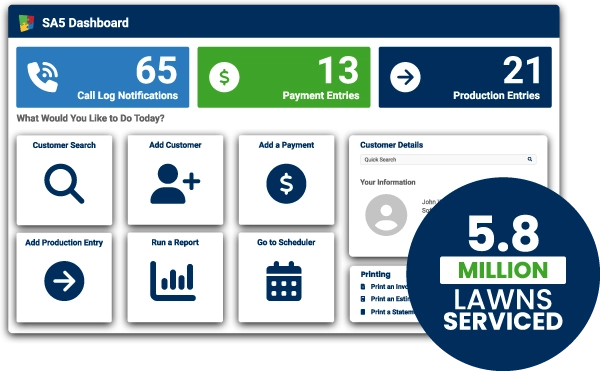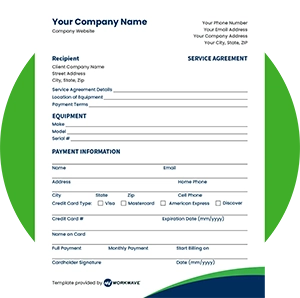Lawn Care Quotes: The Ultimate Guide to Estimation – 7 Steps for Quoting Profitable Jobs
In the competitive world of lawn care services, accurate and profitable quoting is the backbone of a successful business. Whether you’re new to the industry or looking to optimize your existing lawn care business, this comprehensive guide will walk you through the essential steps of creating quotes that ensure profitability while satisfying your customers’ lawn care needs, ultimately helping them achieve a beautiful lawn.
From understanding your local market to leveraging technology and embracing lawn love for efficient quote generation and personalized service, we’ll cover everything you need to know to build a thriving lawn service. By the end of this guide, you’ll have the knowledge and tools to create lawn care quotes that win jobs, maintain happy customers, and drive your business forward.
Let’s dive into the seven crucial steps for mastering lawn care quote estimation.
Step 1: Understand Your Target Market and Local Competition
Before you can create accurate and competitive quotes, it’s essential to have a deep understanding of your target market and the local lawn care industry landscape.
Researching Your Local Lawn Care Market
Identify your service area
Define the geographic boundaries of where you’ll offer your lawn care services. This could be a specific neighborhood, city, or county.
Analyze demographic data
Use census data and local economic reports to understand the characteristics of potential customers in your area. Look for factors like:
- Average income levels
- Homeownership rates
- Average property sizes
- Age distribution of residents
Assess lawn types and conditions
Different regions have varying grass types and lawn care needs. Research the common grass varieties in your area and their specific maintenance requirements.
Evaluating Local Competition
Identify competitors
Make a list of other lawn care businesses operating in your target area. Include both large companies and small local operators.
Analyze their services
Visit competitor websites and gather information on:
- Types of lawn care services offered
- Pricing structures (if available)
- Unique selling propositions or specialties
- Lawn mowing service: Emphasize affordability and convenience
Read customer reviews
Check online review platforms to understand customer satisfaction levels and common complaints about local lawn care services.
Mystery shop
Consider requesting quotes from competitors for a sample property to get a firsthand understanding of their pricing and quoting process. A quick, free estimate is crucial to stay competitive and appeal to customers seeking personalized and affordable lawn care options.
Understanding Customer Expectations
- Conduct surveys or interviews: Reach out to potential customers in your area to understand their lawn care needs, preferences, and pain points.
- Analyze seasonal trends: Understand how lawn care needs and customer demand fluctuate throughout the year in your region.
- Identify value-added services: Look for opportunities to offer services that your competition might be overlooking, such as organic lawn care or water-efficient landscaping.
By thoroughly researching your market, you’ll be better equipped to position your lawn care business effectively and create quotes that resonate with potential customers.

Step 2: Develop a Comprehensive Service Offering
Periodically reassess your offerings to stay competitive.
Consider expanding into specialized services that can set you apart. These might include organic lawn care, drought-resistant landscaping, or eco-friendly pest management. This can be profitable upsells and services to complement your standard landscaping, mowing, and yard maintenance.
When structuring your services, think in terms of tiered packages. A basic package might cover essential maintenance, while premium options could include seasonal treatments, lawn renovation, or even landscape design consultation. This tiered approach not only simplifies your quoting process but also provides clear upselling opportunities.
Remember, your service offerings should be flexible enough to adapt to seasonal changes and varying customer needs. By thoughtfully curating your service menu, you’ll be better positioned to create accurate, tailored quotes that appeal to a wide range of clients.
For guidance on expanding your service offerings and staying updated with industry trends, visit the National Association of Landscape Professionals (NALP). Their resources can help you refine your service menu to attract and retain clients.
Step 3: Measure and Assess Properties Accurately
Accurate property measurement and assessment are fundamental to creating precise lawn care quotes. This step ensures you allocate the right amount of time and resources to each job, maintaining profitability while meeting customer expectations.
Tools for Accurate Measurement
Invest in reliable measuring tools to ensure precision:
- Laser distance measure: For quick and accurate length measurements (Pro Tip: Check out Measurement Assistant to complete estimates and quotes from the office while your sales rep is on the phone to quickly sell.)
- Measuring wheel: Ideal for larger properties or curved areas
- GPS mapping tools: Advanced technology for complex property layouts
- Drone technology: For aerial mapping of extensive properties (if budget allows)
Measuring Techniques
Follow these steps to measure a property effectively:
- Divide the lawn into geometric shapes (rectangles, triangles, circles)
- Measure each section individually
- Calculate the area of each section
- Sum up the areas to get the total lawn size
Remember to account for:
- Slopes and uneven terrain
- Obstacles like trees, flower beds, or hardscaping
- Narrow or hard-to-reach areas that may require special equipment
Property Assessment Factors
Beyond size, assess these factors that can impact service time and difficulty:
- Grass type and condition
- Presence of weeds or bare patches
- Soil quality and drainage
- Shade levels and sun exposure
- Presence of pets or wildlife
- Accessibility (gates, fences, steep driveways)
- Proximity to buildings or delicate landscaping
Creating a Property Profile
For each property, create a detailed profile that includes:
- Total lawn area
- Breakdown of different zones (e.g., front yard, backyard, side strips)
- Notes on specific challenges or requirements (Pro Tip: use Real Green’s condition codes feature to easily note these needs and provide upsells)
- Photos or sketches of the property layout
- Any client preferences or special instructions
Leveraging Technology
Consider using lawn care software or apps that can:
- Store property profiles and measurements
- Calculate service times based on lawn size and conditions
- Track property changes over time
- Generate professional-looking proposals with property details
Additionally, these tools can streamline payment processing, providing a seamless experience for users and allowing clients to focus on enjoying their lawn care service.
Regular Reassessment
Properties can change over time. Implement a system for regular reassessment:
- Schedule annual property reviews
- Train your team to report significant changes they notice during service visits
- Communicate with customers about any modifications they’ve made to their property
By mastering accurate property measurement and assessment, you’ll be able to create more precise quotes, allocate resources efficiently, and avoid underestimating job requirements.


Step 4: Calculate Comprehensive Costs
Understanding Direct Costs
Direct costs are expenses directly tied to providing your lawn care services. These include:
- Labor Costs:
- Wages for yourself and employees
- Payroll taxes and benefits
- Worker’s compensation insurance
- Equipment Costs:
- Depreciation of mowers, trimmers, and other tools
- Fuel and oil
- Maintenance and repairs
- Materials and Supplies:
- Fertilizers and weed control products
- Grass seed and soil amendments
- Disposal fees for yard waste
- Vehicle Expenses:
- Truck or trailer depreciation
- Fuel costs
- Insurance and registration fees
Accounting for Indirect Costs
Indirect costs, while not directly tied to specific jobs, are essential for running your business:
- Overhead Expenses:
- Office rent and utilities
- Administrative staff salaries
- Marketing and advertising
- Professional services (accounting, legal)
- Software subscriptions
- Insurance:
- General liability insurance
- Commercial property insurance
- Professional liability insurance
- Taxes:
- Income taxes
- Sales taxes (if applicable)
- Local business taxes and licenses
Calculating Per-Job Costs
To determine the cost for a specific lawn care job:
- Estimate the time required based on property size and services
- Calculate direct labor costs for that time
- Add a portion of equipment costs based on usage
- Include any specific materials or supplies needed
- Factor in travel time and vehicle expenses
- Add a percentage for overhead costs
Building in Profit Margins
- Determine your desired profit margin and add it to your costs.
- Aim for a margin between 10% to 30%, depending on your local market and business goals.
Leveraging Technology for Cost Calculation
Consider using lawn care business software or spreadsheets to streamline your cost calculations. These tools
- Track actual costs over time
- Compare estimated vs. actual job costs
- Adjust your pricing based on real data
Regular Cost Review
Implement a system for regularly reviewing and updating your costs:
- Review major expense categories monthly
- Analyze profit margins quarterly
- Do a comprehensive cost audit annually
By regularly calculating and reviewing your costs, you create quotes that ensure profitability while remaining competitive in your local lawn care market.
Step 5: Develop a Pricing Strategy
Understand Pricing Models
Consider these common pricing models for lawn care services:
- Per Square Foot: Simple to calculate and easy for customers to understand
- Hourly Rate: Compensate for time spent — good for complex jobs
- Flat Rate Pricing: Predictable for customers, can be more profitable if you work efficiently
- Tiered Pricing: Allows for different service levels, encourages upselling
Factors Influencing Your Pricing Strategy
When developing your pricing strategy, consider:
- Market Position: Are you targeting budget-conscious customers or premium service seekers?
- Service Quality: Higher quality services can command premium prices
- Seasonal Adjustments: Consider higher rates during peak seasons and possible discounts during slower periods
- Customer Loyalty Programs: Offer discounts for long-term contracts or referral bonuses
- Upselling and Cross-selling Opportunities: Structure pricing to encourage additional services
- Minimum Job Sizes: Set a minimum price for small jobs to ensure profitability
- Geographic Considerations: Adjust pricing based on property locations and travel time
Implement Your Pricing Strategy
- Create a Pricing Matrix:
- Develop a clear, easy-to-use pricing guide for your team
- Include variables like property size, service type, and frequency
- Train Your Team:
- Ensure all employees understand your pricing strategy
- Provide guidelines for when and how to offer discounts or negotiate
- Communicate Value to Customers:
- Clearly explain what’s included in each service package
- Highlight the benefits of your services, not just the features
- Regular Price Reviews:
- Set up a schedule to review and adjust prices (e.g., annually)
- Monitor the impact of price changes on customer retention and acquisition
- Flexibility and Customization:
- Be prepared to customize pricing for unique situations or high-value clients
- Consider offering price matching for loyal customers if competitors undercut you
By developing a comprehensive pricing strategy, you’ll be able to create lawn care quotes that attract customers and prove profitable for your business.

Step 6: Create Professional and Detailed Quotes
Craft the Perfect Quote
Quotes are the first opportunity to impress potential clients.
Start with a personal introduction that addresses the client by name and references specific details about their property. This demonstrates your attention to detail and commitment to their unique needs.
Follow this with a clear, concise description of your proposed services. Focus on the benefits to the client rather than just listing services. For example, instead of simply stating “weekly mowing,” explain how regular mowing promotes healthier grass growth and enhances the property’s curb appeal.
Price Transparency and Value Communication
Be clear and transparent with pricing. Here’s how to structure this section:
- Break down costs for each service
- Explain the value behind each line item
- Clearly outline any package deals or discounts
- Include terms and conditions, such as cancellation policies or satisfaction guarantees
Remember, you’re not just selling a service; you’re selling peace of mind and a beautiful lawn. Make sure your quote reflects this value proposition.
Visual Enhancements
Incorporate visual elements to make your quote more engaging and informative:
- Before-and-after photos of similar projects
- Simple diagrams of the client’s property showing service areas
- Your company logo and professional formatting
These visual aids help clients envision the results and justify the value of your services.
Leveraging Technology
Use lawn care software solutions to streamline your quoting process. These tools offer benefits such as:
- Customizable quote templates
- On-site quote generation using tablets or smartphones
- Integration with your customer relationship management (CRM) system
- Professional presentation and branding
Call-to-Action and Next Steps
Conclude your quote with a clear call-to-action. Specify exactly how the client should proceed if they want to accept the quote. This might include:
- Signing electronically
- Calling your office
- Scheduling a follow-up meeting
By making the next steps clear and easy, you increase the likelihood of converting the quote into a job.
Step 7: Implement a System for Quote Management and Follow-Up
Setting Up a Tracking System
Implement a robust system to track and manage your quotes. This could be:
- A spreadsheet for smaller operations
- A full-featured CRM system for larger businesses
Ensure your chosen tool allows you to:
- Categorize quotes (pending, accepted, declined)
- Set reminders for follow-ups
- Store notes about each potential client
- Track conversion rates and other key metrics
Developing a Follow-Up Process
Create a standardized follow-up process to maximize your quote-to-job conversion rate:
- Send an initial email check-in 2-3 days after sending the quote
- Make a phone call a week later if there’s no response
- Be prepared to answer questions and address concerns
- Keep detailed notes of all interactions in your tracking system
Managing Accepted Quotes
For accepted quotes, have a clear process for transitioning from acceptance to service:
- Send a welcome packet with detailed service information
- Schedule an initial consultation or property walk-through
- Set up the client in your scheduling and billing systems
Learning from Declined Quotes
Don’t neglect declined quotes. They offer valuable learning opportunities:
- Follow up to understand why the client chose not to proceed
- Implement an automated survey for declined quotes
- Use this feedback to refine your quoting process and services
Analyzing Quote Data
Regularly review your quote data to identify trends:
- Quote acceptance rate
- Average time from quote to acceptance
- Most popular services or packages
- Common reasons for declined quotes
Use these insights to continually improve your quoting process, pricing strategy, and service offerings.
Ongoing Client Engagement
Remember that quote management extends beyond the initial acceptance:
- Implement regular check-ins with new clients to ensure satisfaction
- Use these check-ins as opportunities for upsells and referrals
- Reach out to past clients with seasonal promotions or new service offerings
By implementing a comprehensive quote management and follow-up system, you’ll not only increase your conversion rate but also build stronger, longer-lasting relationships with your clients.


Download Free Templates for Your Business
Use our free, downloadable templates to quickly create proposals, estimates, contracts, work orders, invoices and receipts for your field service business.
We’ve included templates for lawn care, landscaping, arbor care, irrigation, snow removal and pest control. Easily customize each form to create professional-looking documents.
Mastering Quotes for Your Lawn Care Business
Mastering lawn care quote estimation is an ongoing process that combines attention to detail, market awareness, and continuous improvement. By following these seven steps, you’ll create accurate, competitive quotes that win jobs and foster long-term client relationships.
Remember, your quoting process is often a client’s first impression of your business. A well-crafted quote demonstrates your professionalism and sets the stage for a successful partnership. As you implement these strategies, remain flexible and open to feedback. Regularly review and refine your approach based on client responses, market changes, and your business goals.
To streamline your quoting process even further, consider using premade quote templates. These templates save you time, ensure consistency, and help you present a polished, professional image to new clients.
Follow the strategies outlined in this guide and take advantage of well-designed templates to take your lawn care business to the next level.
Frequently Asked Questions
1. How often should I adjust my lawn care pricing?
Review your pricing strategy at least annually or more frequently if there are significant changes in your costs or the local market. Stay informed about industry trends and competitor pricing to ensure your rates remain competitive and profitable.
2. What factors should I consider when pricing for different seasons?
Seasonal variations can significantly impact lawn care needs. In summer, lawns may require more frequent mowing, while in winter, services like leaf removal or snow clearing might be in demand. Adjust your pricing to reflect the specific services required in each season and the associated costs.
3. How can I attract new customers without underpricing my services?
Instead of lowering your prices, focus on demonstrating the value of your professional lawn care services. Offer free quotes, showcase before-and-after photos of your work, and consider introductory discounts for new customers. Building a reputation for quality service will help you attract and retain happy customers without compromising your profitability.
4. Should I charge differently for residential and commercial lawn care jobs?
Yes, it’s often advisable to have separate pricing structures for residential and commercial clients. Commercial properties typically require more time, equipment, and resources. They may also need services during specific hours or with greater frequency. Adjust your pricing accordingly to reflect these differences and ensure profitability across all types of lawn jobs.
5. How can I incorporate add-on services into my lawn care quotes?
When providing quotes, clearly list your core services and pricing, then offer add-on options such as fertilization, aeration, or landscape maintenance. This allows customers to customize their service plan while giving you opportunities to increase revenue. Consider creating package deals that bundle popular add-ons at a slight discount to encourage upsells.


